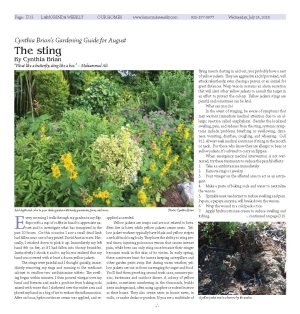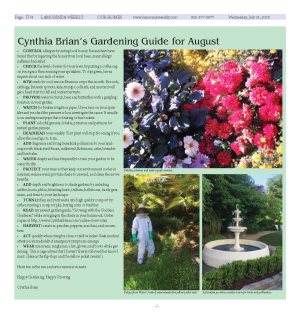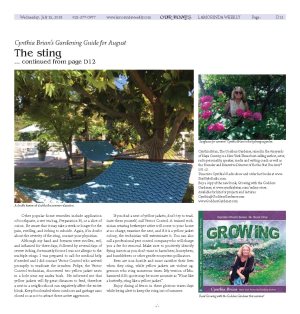|
|
Published July 25th, 2018
|
Cynthia Brian's Gardening Guide for August
|
| The sting |
| By Cynthia Brian |
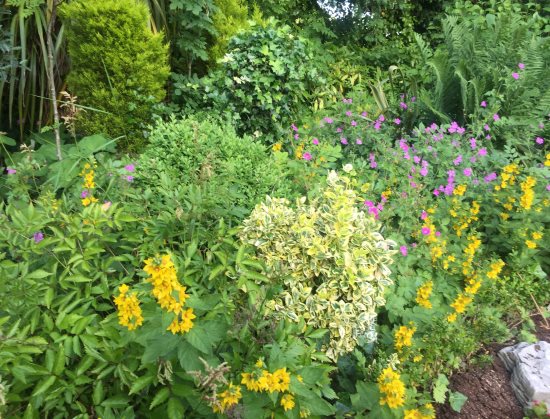 |
| Add depth and color to your shade garden with hardy geraniums, ferns, and more. Photos Cynthia Brian |
"Float like a butterfly, sting like a bee." - Muhammed Ali
 Every morning I walk through my garden in my flip-flops with a cup of coffee in hand to appreciate nature and to investigate what has transpired in the past 20 hours. On this occasion I saw a small dead limb had fallen near one of my prized David Austin roses. Naturally, I reached down to pick it up. Immediately my left hand felt on fire, as if I had fallen into thorny brambles. Instinctively I shook it and to my horror realized that my hand was covered with at least a dozen yellow jackets.
Every morning I walk through my garden in my flip-flops with a cup of coffee in hand to appreciate nature and to investigate what has transpired in the past 20 hours. On this occasion I saw a small dead limb had fallen near one of my prized David Austin roses. Naturally, I reached down to pick it up. Immediately my left hand felt on fire, as if I had fallen into thorny brambles. Instinctively I shook it and to my horror realized that my hand was covered with at least a dozen yellow jackets.
 The stings were painful and I thought quickly, immediately removing my rings and running to the medicine cabinet to swallow two antihistamine tablets. The swelling began within minutes. I then poured vinegar over my hand and forearm and made a poultice from baking soda mixed with water that I slathered over the entire area and placed my hand in a bag of ice to reduce the inflammation. After an hour, hydrocortisone cream was applied, and reapplied as needed.
The stings were painful and I thought quickly, immediately removing my rings and running to the medicine cabinet to swallow two antihistamine tablets. The swelling began within minutes. I then poured vinegar over my hand and forearm and made a poultice from baking soda mixed with water that I slathered over the entire area and placed my hand in a bag of ice to reduce the inflammation. After an hour, hydrocortisone cream was applied, and reapplied as needed.
 Yellow jackets are wasps and are not related to bees. Bees live in hives while yellow jackets create nests. Yellow jacket workers typically have black and yellow stripes one-half-inch long body. They have the ability to sting several times, injecting poisonous venom that causes intense pain, while bees can only sting once because their stinger becomes stuck in the skin of its victim. In early spring, these carnivores hunt for insects keeping caterpillars and other garden pests away. But during warm weather, yellow jackets are out in force scavenging for sugar and food. You'll find them prowling around trash cans, summer picnics, barbecues and outdoor diners. A colony of yellow jackets, sometimes numbering in the thousands, builds nests underground, often using a gopher or rodent burrow as their home. They also create nests in house eaves, in walls, or under decks or porches. If you see a multitude of flying insects darting in and out, you probably have a nest of yellow jackets. They are aggressive and if provoked, will attack relentlessly, even chasing a person or an animal for great distances. Wasp venom contains an alarm secretion that will alert other yellow jackets to assault the target in an effort to protect the colony. Yellow jackets stings are painful and sometimes can be fatal.
Yellow jackets are wasps and are not related to bees. Bees live in hives while yellow jackets create nests. Yellow jacket workers typically have black and yellow stripes one-half-inch long body. They have the ability to sting several times, injecting poisonous venom that causes intense pain, while bees can only sting once because their stinger becomes stuck in the skin of its victim. In early spring, these carnivores hunt for insects keeping caterpillars and other garden pests away. But during warm weather, yellow jackets are out in force scavenging for sugar and food. You'll find them prowling around trash cans, summer picnics, barbecues and outdoor diners. A colony of yellow jackets, sometimes numbering in the thousands, builds nests underground, often using a gopher or rodent burrow as their home. They also create nests in house eaves, in walls, or under decks or porches. If you see a multitude of flying insects darting in and out, you probably have a nest of yellow jackets. They are aggressive and if provoked, will attack relentlessly, even chasing a person or an animal for great distances. Wasp venom contains an alarm secretion that will alert other yellow jackets to assault the target in an effort to protect the colony. Yellow jackets stings are painful and sometimes can be fatal.
 What can you do?
What can you do?
 In the event of stinging, be aware of symptoms that may warrant immediate medical attention due to an allergic reaction called anaphylaxis. Besides the localized swelling, pain, and redness from the sting, systemic symptoms include problems breathing or swallowing, dizziness, vomiting, diarrhea, coughing, and wheezing. Call 911. Always seek medical assistance if stung in the mouth or neck. For those who know they are allergic to bees or yellow jackets, it's advised to carry an Epipen.
In the event of stinging, be aware of symptoms that may warrant immediate medical attention due to an allergic reaction called anaphylaxis. Besides the localized swelling, pain, and redness from the sting, systemic symptoms include problems breathing or swallowing, dizziness, vomiting, diarrhea, coughing, and wheezing. Call 911. Always seek medical assistance if stung in the mouth or neck. For those who know they are allergic to bees or yellow jackets, it's advised to carry an Epipen.
 When emergency medical intervention is not warranted, try these treatments to reduce the painful effects:
When emergency medical intervention is not warranted, try these treatments to reduce the painful effects:
 1. Take an antihistamine immediately.
1. Take an antihistamine immediately.
 2. Remove rings or jewelry.
2. Remove rings or jewelry.
 3. Pour vinegar on the affected area to act as an astringent.
3. Pour vinegar on the affected area to act as an astringent.
 4. Make a paste of baking soda and water to neutralize the venom.
4. Make a paste of baking soda and water to neutralize the venom.
 5. Sprinkle meat tenderizer to reduce swelling and pain. Papain, a papaya enzyme, will break down the venom.
5. Sprinkle meat tenderizer to reduce swelling and pain. Papain, a papaya enzyme, will break down the venom.
 6. Wrap the wound in a cold pack or ice.
6. Wrap the wound in a cold pack or ice.
 7. Apply hydrocortisone cream to reduce swelling and itching.
7. Apply hydrocortisone cream to reduce swelling and itching.
 Other popular home remedies include application of toothpaste, a wet tea bag, Preparation H, or a slice of onion. Be aware that it may take a week or longer for the pain, swelling, and itching to subside. Again, if in doubt about the severity of the sting, contact your physician.
Other popular home remedies include application of toothpaste, a wet tea bag, Preparation H, or a slice of onion. Be aware that it may take a week or longer for the pain, swelling, and itching to subside. Again, if in doubt about the severity of the sting, contact your physician.
 Although my hand and forearm were swollen, red, and inflamed for three days, followed by several days of severe itching, fortunately for me I was not allergic to the multiple stings. I was prepared to call for medical help if needed and I did contact Vector Control who arrived promptly to eradicate the invaders. Felipe, the Vector Control technician, discovered two yellow jacket nests in a hole near my azalea bush. He informed me that yellow jackets will fly great distances to feed, therefore a nest in a neighborhood can negatively affect the entire block. Keep food sealed when outdoors and garbage cans closed so as not to attract these active aggressors.
Although my hand and forearm were swollen, red, and inflamed for three days, followed by several days of severe itching, fortunately for me I was not allergic to the multiple stings. I was prepared to call for medical help if needed and I did contact Vector Control who arrived promptly to eradicate the invaders. Felipe, the Vector Control technician, discovered two yellow jacket nests in a hole near my azalea bush. He informed me that yellow jackets will fly great distances to feed, therefore a nest in a neighborhood can negatively affect the entire block. Keep food sealed when outdoors and garbage cans closed so as not to attract these active aggressors.
 If you find a nest of yellow jackets, don't try to eradicate them yourself, call Vector Control. A trained technician wearing beekeeper attire will come to your home at no charge, examine the nest, and if it is a yellow jacket colony, the technician will exterminate it. You can also call a professional pest control company who will charge you a fee for removal. Make sure to positively identify flying insects as you don't want to harm bees, honeybees, and bumblebees or other gentle ecosystem pollinators.
If you find a nest of yellow jackets, don't try to eradicate them yourself, call Vector Control. A trained technician wearing beekeeper attire will come to your home at no charge, examine the nest, and if it is a yellow jacket colony, the technician will exterminate it. You can also call a professional pest control company who will charge you a fee for removal. Make sure to positively identify flying insects as you don't want to harm bees, honeybees, and bumblebees or other gentle ecosystem pollinators.
 Bees are non-hostile and must sacrifice their lives when they sting, while yellow jackets are violent aggressors who sting numerous times. My version of Muhammed Ali's quote may be more accurate as "Float like a butterfly, sting like a yellow jacket."
Bees are non-hostile and must sacrifice their lives when they sting, while yellow jackets are violent aggressors who sting numerous times. My version of Muhammed Ali's quote may be more accurate as "Float like a butterfly, sting like a yellow jacket."
 Enjoy dining al fresco in these glorious warm days while being alert to keep the sting out of summer.
Enjoy dining al fresco in these glorious warm days while being alert to keep the sting out of summer.
 Cynthia Brian's Gardening Guide for August
Cynthia Brian's Gardening Guide for August
 CONTROL allergies by eating local honey. Researchers have found that by ingesting the honey from local bees, many allergy sufferers find relief.
CONTROL allergies by eating local honey. Researchers have found that by ingesting the honey from local bees, many allergy sufferers find relief.
 CHECK the level of water for your lawn by putting a coffee cup on your grass then running your sprinklers. To stay green, lawns require about one inch of water.
CHECK the level of water for your lawn by putting a coffee cup on your grass then running your sprinklers. To stay green, lawns require about one inch of water.
 SOW seeds for cool season Brassicas crops this month. Broccoli, cabbage, Brussels sprouts, kale, turnips, collards, and mustard will get a head start for fall and winter harvests.
SOW seeds for cool season Brassicas crops this month. Broccoli, cabbage, Brussels sprouts, kale, turnips, collards, and mustard will get a head start for fall and winter harvests.
 PROVIDE water for birds, bees and butterflies with a gurgling fountain in your garden.
PROVIDE water for birds, bees and butterflies with a gurgling fountain in your garden.
 WATCH for broken irrigation pipes. If you turn on your sprinkler and you find the pressure is low, investigate the cause. It usually is an underground pipe that is leaking or has broken.
WATCH for broken irrigation pipes. If you turn on your sprinkler and you find the pressure is low, investigate the cause. It usually is an underground pipe that is leaking or has broken.
 PLANT colorful gazania, lobelia, primrose and petunias for instant garden pizzazz.
PLANT colorful gazania, lobelia, primrose and petunias for instant garden pizzazz.
 DEADHEAD roses weekly. Your plant will stop blooming if you allow the rose hips to form.
DEADHEAD roses weekly. Your plant will stop blooming if you allow the rose hips to form.
 ADD fragrance and bring beneficial pollinators to your landscape with black-eyed Susan, milkweed, Echinacea, aster, lavender and bee balm.
ADD fragrance and bring beneficial pollinators to your landscape with black-eyed Susan, milkweed, Echinacea, aster, lavender and bee balm.
 WATER deeply and less frequently to train your garden to be water thrifty.
WATER deeply and less frequently to train your garden to be water thrifty.
 PROTECT your trees as they keep our environment cooler in summer, reduce wind, provide shade to unwind, and clean the air we breathe.
PROTECT your trees as they keep our environment cooler in summer, reduce wind, provide shade to unwind, and clean the air we breathe.
 ADD depth and brightness to shade gardens by including astilbe, hosta, phlox, bleeding heart, trillium, helleborus, hardy geranium, and ferns to your landscape.
ADD depth and brightness to shade gardens by including astilbe, hosta, phlox, bleeding heart, trillium, helleborus, hardy geranium, and ferns to your landscape.
 TURN kitchen and yard waste into high quality compost by either creating a compost pile, buying a bin or tumbler.
TURN kitchen and yard waste into high quality compost by either creating a compost pile, buying a bin or tumbler.
 READ my newest garden guide, "Growing with the Goddess Gardener," while swinging in the shade in your hammock. Order copies at http://www.CynthiaBrian.com/online-store today.
READ my newest garden guide, "Growing with the Goddess Gardener," while swinging in the shade in your hammock. Order copies at http://www.CynthiaBrian.com/online-store today.
 HARVEST tomatoes, peaches, peppers, zucchini, and cucumbers.
HARVEST tomatoes, peaches, peppers, zucchini, and cucumbers.
 ACT quickly when stung by a bee or yellow jacket. Seek medical attention immediately if emergency symptoms emerge.
ACT quickly when stung by a bee or yellow jacket. Seek medical attention immediately if emergency symptoms emerge.
 WEAR sunscreen, sunglasses, a hat, gloves, and boots while gardening. This is sage advice that I haven't always followed but know I must. (Hence the flip-flops and the yellow jacket swarm!)
WEAR sunscreen, sunglasses, a hat, gloves, and boots while gardening. This is sage advice that I haven't always followed but know I must. (Hence the flip-flops and the yellow jacket swarm!)

 Have fun in the sun and savor summer sunsets.
Have fun in the sun and savor summer sunsets.

 Happy Gardening. Happy Growing.
Happy Gardening. Happy Growing.

 Cynthia Brian
Cynthia Brian


|
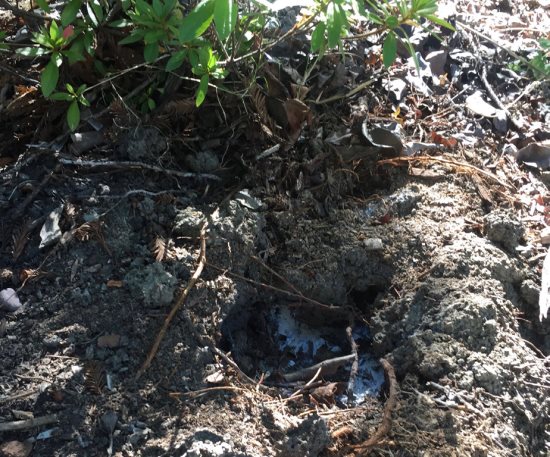 |
| A yellow jacket nest in a burrow by the azalea. |
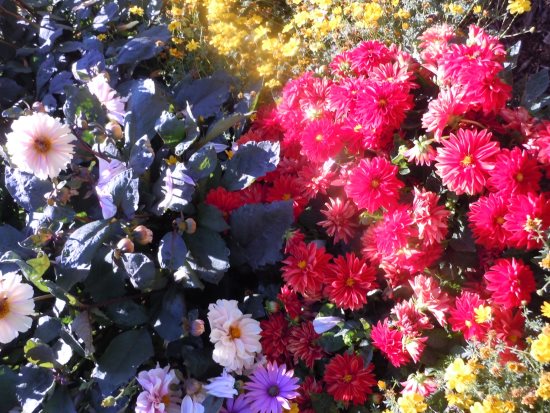 |
| Dahlias, zinnias, and asters speak summer. |
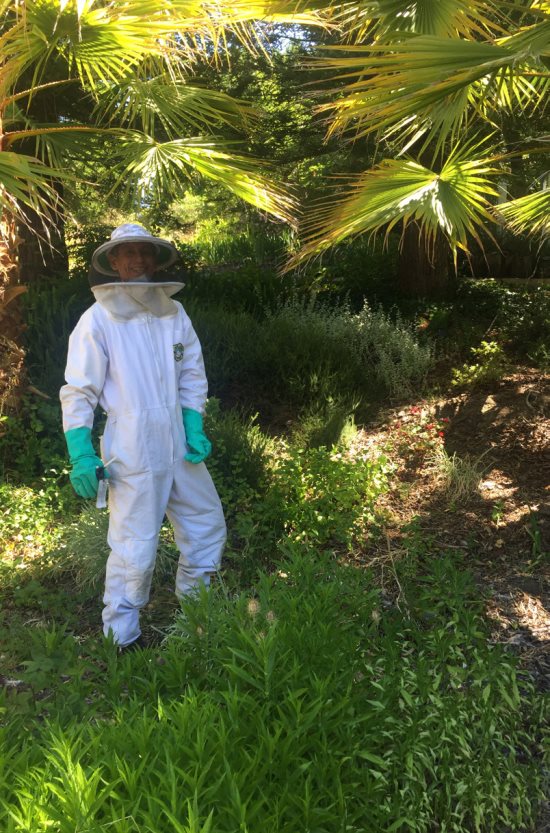 |
| Felipe, from Vector Control, exterminates the yellow jacket nest. |
 |
| A fountain provides a water source for birds and pollinators. |
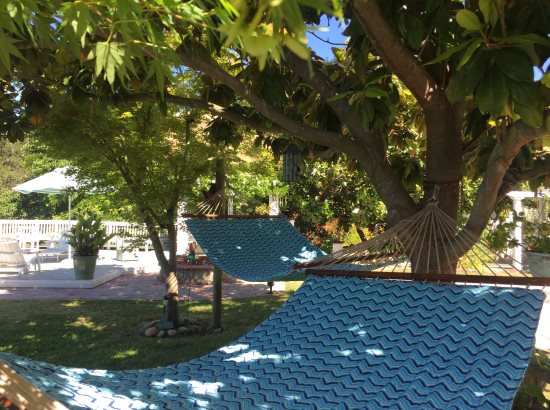 |
| |
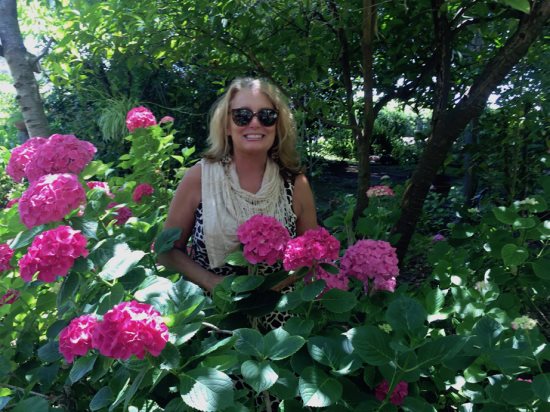 |
Sunglasses for summer! Cynthia Brian in the hydrangea garden.
Cynthia Brian, The Goddess Gardener, raised in the vineyards of Napa County, is a New York Times best-selling author, actor, radio personality, speaker, media and writing coach as well as the Founder and Executive Director of Be the Star You Are1(r) 501 c3. Tune into Cynthia's Radio show and order her books at
www.StarStyleRadio.com. Buy a copy of the new book, Growing with the Goddess Gardener, at
www.cynthiabrian.com/online-store. Available for hire for projects and lectures.
www.GoddessGardener.com
|
| |
|
|
|









